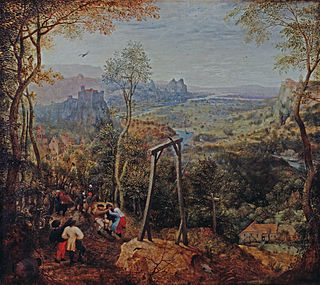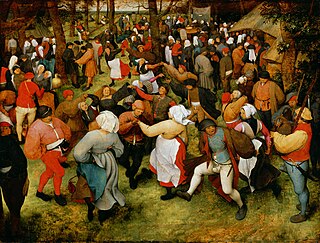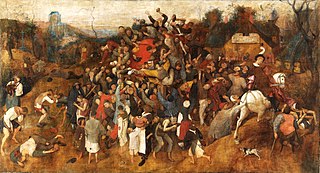 W
WThe following is a list of paintings by the Dutch and Flemish Renaissance painter and printmaker Pieter Bruegel the Elder.
 W
WThe Adoration of the Kings is an oil-on-panel painting of the Adoration of the Magi by the Netherlandish Renaissance artist Pieter Bruegel the Elder, painted in 1564, and now in the National Gallery, London.
 W
WAdoration of the Magi in a Winter Landscape or Adoration of the Magi in the Snow is a 1563 painting by Pieter Bruegel the Elder, now in the Oskar Reinhart Collection Am Römerholz in Winterthur, Switzerland.
 W
WThe Beggars or The Cripples is an oil-on-panel by the Netherlandish Renaissance artist Pieter Bruegel the Elder, painted in 1568. It is now in the Louvre in Paris.
 W
WThe Blind Leading the Blind, Blind, or The Parable of the Blind is a painting by the Netherlandish Renaissance artist Pieter Bruegel the Elder, completed in 1568. Executed in distemper on linen canvas, it measures 86 cm × 154 cm. It depicts the Biblical parable of the blind leading the blind from the Gospel of Matthew 15:14, and is in the collection of the Museo di Capodimonte in Naples, Italy.
 W
WThe Census at Bethlehem is an oil-on-panel by the Flemish Renaissance artist Pieter Bruegel the Elder, painted in 1566. It is signed and measures about 115,5 cm × 164,5 cm. It is currently held and exhibited at the Royal Museums of Fine Arts of Belgium in Brussels, which acquired it in 1902. It is one of the first paintings in western art to feature a significant snow landscape and was painted in the aftermath of the winter of 1565, which was one of the harshest winters on record.
 W
WChildren's Games is an oil-on-panel by Flemish Renaissance artist Pieter Bruegel the Elder, painted in 1560. It is currently held and exhibited at the Kunsthistorisches Museum in Vienna.
 W
WChrist and the Woman Taken in Adultery is a small panel painting in grisaille by the Netherlandish Renaissance printmaker and painter Pieter Bruegel the Elder. It is signed and dated 1565.
 W
WConversion of Paul is an oil-on-panel by the Netherlandish Renaissance artist Pieter Bruegel the Elder, painted in 1567. It is currently held and exhibited at the Kunsthistorisches Museum in Vienna.
 W
WDulle Griet, also known as Mad Meg, is a figure of Flemish folklore who is the subject of a 1563 oil-on-panel by Flemish renaissance artist Pieter Bruegel the Elder. The painting depicts a virago, Dulle Griet, who leads an army of women to pillage Hell, and is currently held and exhibited at the Museum Mayer van den Bergh in Antwerp.
 W
WThe Fall of the Rebel Angels is an oil-on-panel art piece painted in 1562 by the Netherlandish Renaissance artist, Pieter Bruegel the Elder. The painting is 117cm x 162cm and is currently held in the Royal Museums of Fine Arts of Belgium in Brussels. The Fall of Rebel Angels depicts Lucifer along with the other fallen angels that have been banished from heaven. Angels are falling from the sun in a stacked manner along with ungodly creatures that Bruegel created. This piece by Bruegel was previously thought to be a Hieronymus Bosch piece. Bruegel was influenced by a variety of artists such as Albrecht Dürer, Frans Floris I, and Hieronymus Bosch. He also got ideas for the creation of his creatures in his previous works, such as The Last Judgement.
 W
WThe Fight Between Carnival and Lent was painted by Pieter Bruegel the Elder in 1559. It is a panorama of contemporary life in the Southern Netherlands. While the painting contains nearly 200 characters, it is unified under the theme of the transition from Shrove Tuesday to Lent, the period between Christmas and Easter.
 W
WThe Gloomy Day is an oil on wood painting by Pieter Bruegel in 1565. The painting is one in a series of six works, five of which are still extant, that depict different times of the year. The painting is currently in the collection of the Kunsthistorisches Museum, located in Vienna, Austria.
 W
WThe Harvesters is an oil painting on wood completed by Pieter Bruegel the Elder in 1565. It depicts the harvest time, in the months of July and August or late summer. Nicolaes Jonghelinck, a merchant banker and art collector from Antwerp, commissioned this painting.
 W
WThe Hay Harvest, is an oil on wood painting created by Pieter Bruegel, in 1565. The most important of the Lobkowiczes' Northern pictures, it was hung in the dining room of the Antwerp merchant Niclaes Jongelink. This picture was originally part of a series of six panels, each presumed to represent two months of the year – in this case June and July.
 W
WThe Hunters in the Snow, also known as The Return of the Hunters, is a 1565 oil-on-wood painting by Pieter Bruegel the Elder. The Northern Renaissance work is one of a series of works, five of which still survive, that depict different times of the year. The painting is in the collection of the Kunsthistorisches Museum in Vienna, Austria. This scene is set in the depths of winter during December/January.
 W
WHet Luilekkerland — known in English as The Land of Cockaigne — is a 1567 oil painting by Pieter Bruegel the Elder. In medieval times, Cockaigne was a mythical land of plenty, but Bruegel's depiction of Cockaigne and its residents is not meant to be a flattering one. He chooses rather a comic illustration of the spiritual emptiness believed to derive from gluttony and sloth, two of the seven deadly sins.
 W
WLandscape with the Fall of Icarus is a painting in oil on canvas measuring 73.5 by 112 centimetres currently displayed in the Royal Museums of Fine Arts of Belgium in Brussels. It was long thought to be by the leading painter of Dutch and Flemish Renaissance painting, Pieter Bruegel the Elder. However, following technical examinations in 1996 of the painting hanging in the Brussels museum, that attribution is regarded as very doubtful, and the painting, perhaps painted in the 1560s, is now usually seen as a good early copy by an unknown artist of Bruegel's lost original, perhaps from about 1558. According to the museum: "It is doubtful the execution is by Bruegel the Elder, but the composition can be said with certainty to be his", although recent technical research has re-opened the question.
 W
WLandscape with the Flight into Egypt is a 1563 oil on wooden board painting by Pieter Bruegel the Elder, showing the biblical Flight into Egypt of Mary and Joseph with the infant Jesus. It measures 37.1 by 55.6 centimetres and is displayed at the Courtauld Gallery in London.
 W
WThe Magpie on the Gallows is a 1568 oil-on-wood panel painting by the Netherlandish Renaissance artist Pieter Bruegel the Elder. It is now in the Hessisches Landesmuseum in Darmstadt.
 W
WSeveral oil-on-oak-panel versions of The Massacre of the Innocents were painted by 16th-century Netherlandish painters Pieter Bruegel the Elder and his son Pieter Brueghel the Younger. The work translates the Biblical account of the Massacre of the Innocents into a winter scene in the Netherlands in the prelude to the Dutch Revolt against Spanish rule, also known as the Eighty Years' War.
 W
WThe Misanthrope is a tempera painting on canvas by the Flemish Renaissance artist Pieter Bruegel the Elder, created during 1568. It currently is held and exhibited at the National Museum of Capodimonte in Naples, Italy.
 W
WNaval Battle in the Gulf of Naples is an oil painting on panel by the Flemish Renaissance artist Pieter Bruegel the Elder, painted from 1558 to 1562. It is in the Doria Pamphilj Gallery in Rome.
 W
WNetherlandish Proverbs is a 1559 oil-on-oak-panel painting by Pieter Bruegel the Elder that depicts a scene in which humans and, to a lesser extent, animals and objects, offer literal illustrations of Dutch-language proverbs and idioms.
 W
WParable of the Sower is a 1557 landscape painting by Dutch and Flemish painter Pieter Bruegel the Elder. It is now in the Timken Museum of Art in San Diego.
 W
WThe Peasant and the Nest Robber is an oil-on-panel painting by the Netherlandish Renaissance artist Pieter Bruegel the Elder, painted in 1568. It is in the Kunsthistorisches Museum in Vienna.
 W
WThe Peasant Dance is an oil-on-panel by the Netherlandish Renaissance artist Pieter Bruegel the Elder, painted in circa 1567. It was looted by Napoleon Bonaparte and brought to Paris in 1808, being returned in 1815. Today it is held by and exhibited at the Kunsthistorisches Museum in Vienna.
 W
WThe Peasant Wedding is a 1567 genre painting by the Dutch and Flemish Renaissance painter and printmaker Pieter Bruegel the Elder, one of his many depicting peasant life. It is now in the Kunsthistorisches Museum, Vienna. Pieter Bruegel the Elder enjoyed painting peasants and different aspects of their lives in so many of his paintings that he has been called Peasant-Bruegel, but he was an intellectual, and many of his paintings have a symbolic meaning as well as a moral aspect.
 W
WThe Procession to Calvary is an oil-on-panel by the Netherlandish Renaissance artist Pieter Bruegel the Elder of Christ carrying the Cross set in a large landscape, painted in 1564. It is in the Kunsthistorisches Museum in Vienna.
 W
WThe Return of the Herd is an oil on wood painting by Pieter Bruegel in 1565. The painting is one in a series of six works that depict different seasons. The painting is currently in the collection of the Kunsthistorisches Museum, located in Vienna, Austria. The autumnal colors of the landscape and the bare trees connect this particular painting to October/November.
 W
WThe Sermon of Saint John the Baptist is a painting of 1566 by Pieter Bruegel the Elder in the Museum of Fine Arts in Budapest.
 W
WStorm at Sea is an oil painting on panel by the Netherlandish Renaissance artist Pieter Bruegel the Elder, painted in c. 1569. It is in the Kunsthistorisches Museum in Vienna.
 W
WThe Suicide of Saul is an oil-on-panel by the Netherlandish Renaissance artist Pieter Bruegel the Elder, painted in 1562. It is in the collection of the Kunsthistorisches Museum in Vienna.
 W
WThe Tower of Babel was the subject of three paintings by Pieter Bruegel the Elder. The first, a miniature painted on ivory, was painted while Bruegel was in Rome and is now lost. The two surviving paintings, often distinguished by the prefix "Great" and "Little", are in the Kunsthistorisches Museum, Vienna and the Museum Boijmans Van Beuningen in Rotterdam respectively. Both are oil paintings on wood panels.
 W
WThe Triumph of Death is an oil panel painting by Pieter Bruegel the Elder painted c. 1562. It has been in the Museo del Prado in Madrid since 1827.
 W
WTwo Monkeys or Two Chained Monkeys is a 1562 painting by Dutch and Flemish Renaissance artist Pieter Bruegel the Elder. The work is now in the Gemäldegalerie of the Berlin State Museums.
 W
WThe Wedding Dance is a 1566 oil-on-panel painting by Pieter Bruegel the Elder. Owned by the museum of the Detroit Institute of Arts in Detroit, Michigan, the work was discovered by its director in England in 1930, and brought to Detroit. It is believed to be one of a set of three Bruegel works from around the same time: The Wedding Dance, The Peasant Wedding (1567) and The Peasant Dance (1569).
 W
WThe Wine of Saint Martin's Day is the largest painting by Pieter Bruegel the Elder. It is currently held in the Museo del Prado, Madrid, where it was identified as a Bruegel original in 2010. Like much of Bruegel's work it depicts peasant life, in this case a festival known as St. Martin's Day, which involves drinking the first wine of the season.
 W
W